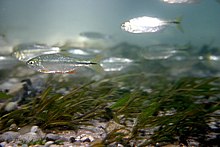
Characidae, the characids or characins, is a family of freshwater subtropical and tropical fish belonging to the order Characiformes. The name "characins" is an historical one, but scientists today tend to prefer "characids" to reflect their status as a, by and large, monophyletic group. To arrive there, this family has undergone much systematic and taxonomic change. Among those fishes remaining in the Characidae currently are the tetras, comprising the very similar genera Hemigrammus and Hyphessobrycon, as well as a few related forms, such as the cave and neon tetras. Fish of this family are important as food in several regions, and also constitute a large percentage of captive freshwater aquarium fish species.

Hyphessobrycon is a genus of freshwater fish in the family Characidae. These species are among the fishes known as tetras. The genus is distributed in the Neotropical realm from southern Mexico to Río de la Plata in Argentina. Many of these species are native to South America; about six species are from Central America and a single species, H. compressus is from southern Mexico.

Astyanax jordani is a freshwater fish of the characin family of order Characiformes, native to Mexico. It is sometimes called the cave tetra, or by its local Spanish name sardina ciega.

Moenkhausia is a genus of freshwater fish in the family Characidae native to tropical and subtropical South America. These are medium-sized tetras where the largest species only reach around 12 cm (4.7 in).

Hemibrycon is a genus of characins. They are mainly found in South America, Trinidad in the Caribbean), and H. dariensis of east Panama.

Hemigrammus is a genus of freshwater fish in the family Characidae native to South America and commonly seen in the aquarium trade. These are medium-small tetras where the largest species reach up to around 11 cm (4.3 in).
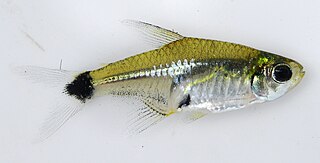
Serrapinnus is a genus of characins from tropical South America.

Characidium is a genus of fish in the family Crenuchidae. They are mainly found in South America, but C. marshi is from Panama. They are small, slender fish that live on the bottom in flowing fresh waters and feed on small animals such as insects.
Heiko Bleher is a German researcher, author, photographer, and filmmaker. He is best known in the scientific community for his contribution to the exploration of fresh and brackish water habitats worldwide. He has discovered numerous species of fish and aquatic plant, several of which carry his name or are named in honor of Bleher's family.
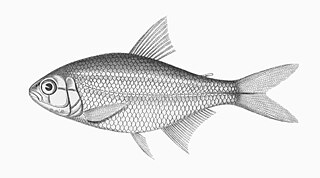
Astyanax argentatus is a small freshwater fish native to northern Central America and southern North America. Given its native range, it is also known as the Texan tetra. Little has been published regarding the feeding habits or behavior of A. argentatus, but it is known to have the northernmost distribution of any member of the genus Astyanax.

The tailspot tetra is a freshwater fish that lives in the coastal river regions of upper South America. Both its common and scientific names reference the distinct spot of color present on the tail fin, which is one of its defining characteristics. It is a small fish, reaching 4.8 in at its longest. Despite its small size, it is an active swimmer, with a preference for fast-flowing waters.
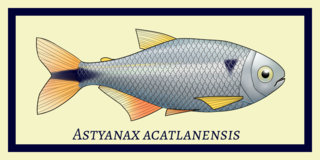
Astyanax acatlanensis, sometimes called the Acatlán tetra, is a small species of fish from the rivers of Mexico. It is a relatively hardy species that is able to tolerate a variety of water conditions, but is only found in freshwater, never brackish or marine. It is known only from the Río Acatlán, which is its type locality, and the Río Jía, which is a small, unknown river in the Oaxaca region.

Astyanax aeneus, the banded tetra, is a small species of fish native to southern Central America and northern South America. It can be found in a variety of environments, including lakes, rivers, ponds, and slightly brackish locales like lagoons. As well as a varied habitat, it has a varied omnivorous diet: algae, seeds, leaves, insects, and fish fry appear to be the most common.

Astyanax angustifrons, sometimes referred to as the Campeche tetra, is a small freshwater fish from the rivers of Central and South America. It has a healthy distribution across southern Mexico and northern Guatemala, and is relatively common within its native range. Details regarding its diet and behavior are sparse, but it lives in areas with plentiful riparian vegetation, and most other members of the genus are omnivorous. Its habitat includes places affected by pollution and human activity; nonetheless, it is not endangered.

Astyanax asuncionensis is a small species of freshwater fish described in 1972 from Asunción, the capital of Paraguay in South America. Its specific epithet is in reference to this. Currently, its range is known to encompass areas of not just Paraguay but also Argentina and Brazil. It is an adaptable, omnivorous species that easily lives in sympatry with various congeners.
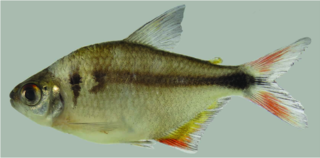
Astyanax bagual is a small species of freshwater fish known only from the Taquari-Antas river basin in southern Brazil. It is unusual in the genus Astyanax because mature male specimens display bony hooks on the rays of all fins; in opposition, most others have them on the anal, pelvic, or pectoral fins - sometimes on more than one of these, but very rarely on all fins. It can further be told apart from various congeners by way of dentition and some aspects of coloration, including the presence of two humeral spots instead of one.

Astyanax bourgeti is a small species of freshwater fish native to the upper Amazon river in Brazil. Originally described in 1908, it is not a particularly well-studied member of the genus Astyanax, but there is enough information available to establish a native range, an appearance, and potential relationships to congeners; for example, A. bourgeti is a known member of the subgenus Poecilurichthys, and has been considered such for most of its existence. Biotope preferences, sympatry, diet, and behavior are all unknown.

Astyanax brachypterygium is a small species of freshwater fish endemic to a collection of high-elevation streams in Brazil. It was named in 2001 alongside congener Astyanax cremnobates, to which it bears a strong resemblance; physical details help to differentiate between the two. Its scales are a greenish-brown on the back and silver on the belly, with reddish fins and a dark humeral spot. One of its defining features is a notably short anal-fin base, which has 13 to 15 rays.

Astyanax clavitaeniatus is a small species of freshwater fish native to various rivers in the Amazon basin. It is characterized by a club-shaped lateral stripe, which is where it gets its scientific name; "clava" means "club", and "taenia" means "stripe". It is a deep-bodied fish with a silvery base color, which is not uncommon for members of Astyanax. Its markings - including a humeral spot and two vertical brown bars - indicate that it is a part of a species complex centered around congener Astyanax bimaculatus.

Psalidodon is a genus of freshwater fish in the family Characidae of the order Characiformes. Some of these fish, like many of their relatives, are kept as aquarium pets and known collectively as tetras.
